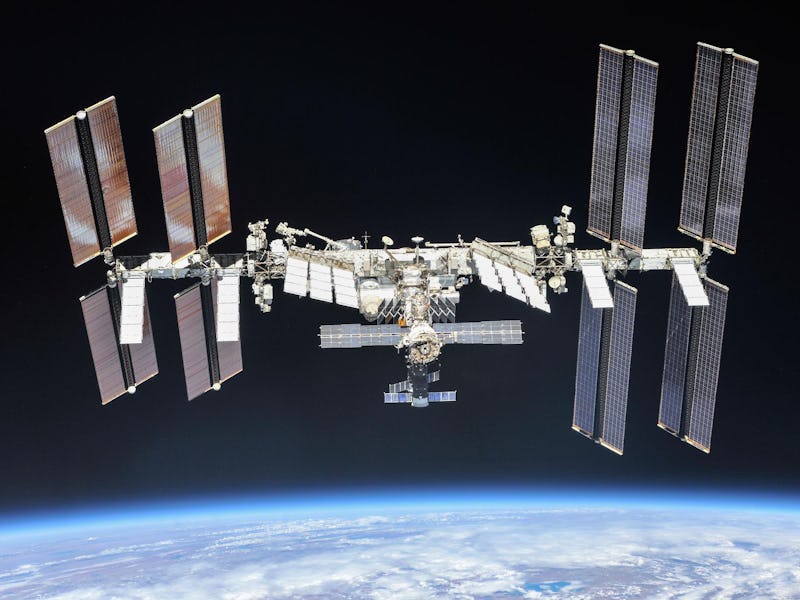With Starliner Astronauts Stuck Indefinitely, The ISS Might Tie A 15-Year-Old Spaceflight Record
If the Boeing Starliner test crew stays in space for much longer, the space lab will get really crowded.

The next 72 hours will be critical to determining just how crowded the International Space Station (ISS) could soon get.
This afternoon, the program manager of NASA’s Commercial Crew Program, Steve Stich, will meet with the program manager of the ISS, Dana Weigel. They’ll discuss different options to accommodate, or avoid altogether, tying the record for most people to ever live on the space station at once.
According to a NASA press briefing on Thursday morning, the Boeing Starliner spacecraft won’t be leaving its parking spot at the ISS anytime soon. When reporters asked for an estimate of the next possible return date for Starliner — which carried astronauts Butch Wilmore and Suni Williams to space on June 5 for what was supposed to be an 8-day flight — Stich hesitated to provide one.
“Boy, I’d hate to pick a date,” Stich told reporters.
The Starliner spacecraft of NASA’s Boeing Crew Flight Test. In this picture, the vehicle and the space station pass 263 miles above the Mediterranean Sea.
The ISS is scheduled to receive four more astronauts in mid-August, when NASA astronauts Zena Cardman, Nick Hague, Stephanie Wilson and Russian cosmonaut Alexsandr Gorbunov are set to reach the station via a SpaceX Dragon spacecraft for the Crew-9 mission.
Wilmore and Williams have already outstretched their initial mission timeline by seven weeks, and counting — and may not come home until the middle or end of August, right when Crew-9 is meant to arrive.
What happens when the ISS gets overcrowded?
In addition to Williams and Wilmore, there are seven other people currently at the station; the seven are known collectively as ISS Expedition 71. They include Crew-8, which launched in March. It’s four passengers — NASA astronauts Matthew Dominick, Michael Barratt, Jeanette Epps and Russian cosmonaut Alexander Grebenkin — aren’t scheduled to leave the ISS until the fall. (Typically, Dragon Crews overlap on the space station by a few days. Crew-8, for instance, reached the ISS six days before Crew-7 undocked.) The rest of Expedition 71 includes the passengers of the Russian Soyuz MS-25 spacecraft. It won’t bring home NASA astronaut Tracy Dyson and Russian cosmonauts Nikolai Chub and Oleg Kononenko until September.
If they’re all onboard the orbiting laboratory at once, the population would reach 13, tying the all-time record set exactly 15 years ago in July 2009.
In addition to today’s discussions that would either prevent or accommodate for the possible record-tying rendezvous, there will soon be a new hot-fire test for Starliner.
What could finally bring Starliner home?
After weeks of testing at NASA’s White Sands Testing Facility in New Mexico, NASA and Boeing personnel think they’ve got an idea about what’s been causing the thruster problems that have left Wilmore and Williams stuck in space. On either Saturday or Sunday, Stich says, mission control will send commands to fire Starliner’s thrusters through a number of pulses to further evaluate the system.
NASA and Boeing leadership have said over the last month that Starliner is safe for the crew to use in case of an emergency scenario where they’d need to vacate the ISS. They’ve added that, since Starliner’s problematic hardware will be discharged into space, teams won’t get the chance to take those components apart to actually see what caused their issue. This is the reason they’ve given for Starliner’s crew remaining in space: As long as the thrusters still exist, they can go back and forth between the ground and orbital tests to get as much information as possible.
Stich provided a vague return window. Wilmore and Williams won’t land before mid- to late-August, he said, pending other procedures.
If Wilmore and Williams weren’t satisfied with making history as Starliner’s first flight test crew, they may have the crowded ISS record-tie under their belts, too.